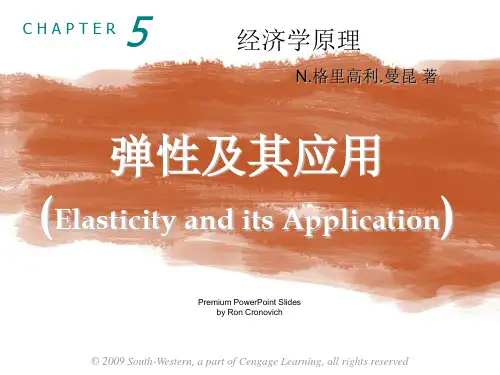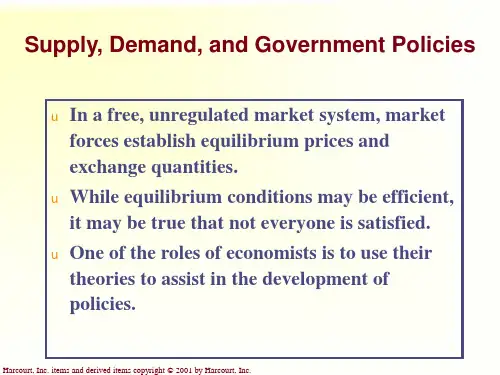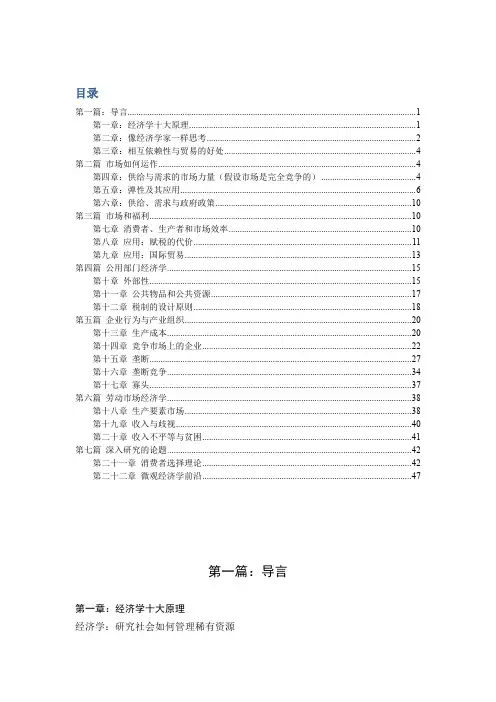曼昆经济学原理第5版微观PPT第六章(6)免费中文版
- 格式:ppt
- 大小:1.01 MB
- 文档页数:35



目录第一篇:导言 (1)第一章:经济学十大原理 (1)第二章:像经济学家一样思考 (2)第三章:相互依赖性与贸易的好处 (4)第二篇市场如何运作 (4)第四章:供给与需求的市场力量(假设市场是完全竞争的) (4)第五章:弹性及其应用 (6)第六章:供给、需求与政府政策 (10)第三篇市场和福利 (10)第七章消费者、生产者和市场效率 (10)第八章应用:赋税的代价 (11)第九章应用:国际贸易 (13)第四篇公用部门经济学 (15)第十章外部性 (15)第十一章公共物品和公共资源 (17)第十二章税制的设计原则 (18)第五篇企业行为与产业组织 (20)第十三章生产成本 (20)第十四章竞争市场上的企业 (22)第十五章垄断 (27)第十六章垄断竞争 (34)第十七章寡头 (37)第六篇劳动市场经济学 (38)第十八章生产要素市场 (38)第十九章收入与歧视 (40)第二十章收入不平等与贫困 (41)第七篇深入研究的论题 (42)第二十一章消费者选择理论 (42)第二十二章微观经济学前沿 (47)第一篇:导言第一章:经济学十大原理经济学:研究社会如何管理稀有资源人们如何做出决策原理一:人们面临权衡取舍(效率与平等不可兼得)原理二:一种东西的成本是为了得到它而放弃的东西,成本也即机会成本原理三:“理性人”考虑边际量(边际成本、边际利益)物品的数量越多,一单位物品带来的利益越小(这就是钻石比水贵的原因)原理四:人们会对激励做出反应人们如何相互交易原理五:贸易可以使每个人的状况变得更好在贸易中没有输赢,双方是互赢的。
原理六:“市场经济”是组织经济活动的一种好方法市场经济有一只“看不见的手”,这只手能促进效率最大化,实现资源的有效配置,价格是看不见的手用来指引经济活动的工具。
“计划经济”中的价格不是由市场决定的,而是由政府规定的,束缚了看不见的手而导致失败。
原理七:政府有时可以改善市场结果(仅仅是“有时”而已,政府有时只是权势们用来实现私利的工具)1.市场经济的基础是“私有制”,它需要政府来实行“产权”制度2.市场经济能够促进效率最大化但无关乎平等,政府需要保证“效率”与“平等”效率方面:市场不总是有效率的,当存在“外部性”(一个人的行为对旁观者福利的影响)或者“市场势力”(某个经济群体能够控制价格)时,市场将不能有效配置资源,这被称为“市场失灵”。



曼昆《经济学原理(微观经济学分册)》(第6版)第6章供给、需求与政府政策课后习题详解跨考网独家整理最全经济学考研真题,经济学考研课后习题解析资料库,您可以在这里查阅历年经济学考研真题,经济学考研课后习题,经济学考研参考书等内容,更有跨考考研历年辅导的经济学学哥学姐的经济学考研经验,从前辈中获得的经验对初学者来说是宝贵的财富,这或许能帮你少走弯路,躲开一些陷阱。
以下内容为跨考网独家整理,如您还需更多考研资料,可选择经济学一对一在线咨询进行咨询。
一、概念题1.价格上限(price ceiling)答:价格上限又称限制价格,指可以出售一种物品的法定最高价格。
如果价格上限高于均衡价格,这种价格上限对价格或销售没有影响,被称为没有限制作用的价格上限;如果价格上限低于均衡价格,则价格上限会导致经济偏离均衡状态,使得需求量大于供给量,引起短缺,这种价格上限属于有限制作用的价格上限。
政府解决供给不足主要有两种方法:配给制和排队。
在实行价格上限时还必然出现黑市交易。
在这样的政策下,得益的是能以低廉的价格买到商品的消费者,而生产者和买不到商品的消费者的利益则受到损害。
2.价格下限(price floor)答:价格下限又称支持价格,指可以出售一种物品的法定最低价格。
如果价格下限低于均衡价格时,这种价格下限对价格或销售量没有影响,可以称为没有限制作用的价下限;如果价格下限高于均衡价格时,价格下限会使得经济偏离均衡状态,最终价格等于价格下限规定的水平,供给量大于需求量,引起过剩,这种价格下限被称为有限制作用的价格下限。
许多国家实行的农产品支持价格和最低工资都属于价格下限。
就农产品支持价格而言,目的是稳定农业生产和农民的收入,有其积极意义,但这也导致了农产品过剩,不利于市场调节下的农业结构调整。
3.税收归宿(tax incidence)(深圳大学2009研)答:税收归宿是指税收负担的最终归属点或税负转嫁的最后结果。
它是关于税收负担分配的问题,指税收最终导致哪些人的福利损失,也就是税收最终由哪些人负担了。

曼昆《经济学原理(微观经济学分册)》(第6版)第6章供给、需求与政府政策课后习题详解跨考网独家整理最全经济学考研真题,经济学考研课后习题解析资料库,您可以在这里查阅历年经济学考研真题,经济学考研课后习题,经济学考研参考书等内容,更有跨考考研历年辅导的经济学学哥学姐的经济学考研经验,从前辈中获得的经验对初学者来说是宝贵的财富,这或许能帮你少走弯路,躲开一些陷阱。
以下内容为跨考网独家整理,如您还需更多考研资料,可选择经济学一对一在线咨询进行咨询。
一、概念题1.价格上限(price ceiling)答:价格上限又称限制价格,指可以出售一种物品的法定最高价格。
如果价格上限高于均衡价格,这种价格上限对价格或销售没有影响,被称为没有限制作用的价格上限;如果价格上限低于均衡价格,则价格上限会导致经济偏离均衡状态,使得需求量大于供给量,引起短缺,这种价格上限属于有限制作用的价格上限。
政府解决供给不足主要有两种方法:配给制和排队。
在实行价格上限时还必然出现黑市交易。
在这样的政策下,得益的是能以低廉的价格买到商品的消费者,而生产者和买不到商品的消费者的利益则受到损害。
2.价格下限(price floor)答:价格下限又称支持价格,指可以出售一种物品的法定最低价格。
如果价格下限低于均衡价格时,这种价格下限对价格或销售量没有影响,可以称为没有限制作用的价下限;如果价格下限高于均衡价格时,价格下限会使得经济偏离均衡状态,最终价格等于价格下限规定的水平,供给量大于需求量,引起过剩,这种价格下限被称为有限制作用的价格下限。
许多国家实行的农产品支持价格和最低工资都属于价格下限。
就农产品支持价格而言,目的是稳定农业生产和农民的收入,有其积极意义,但这也导致了农产品过剩,不利于市场调节下的农业结构调整。
3.税收归宿(tax incidence)(深圳大学2009研)答:税收归宿是指税收负担的最终归属点或税负转嫁的最后结果。
它是关于税收负担分配的问题,指税收最终导致哪些人的福利损失,也就是税收最终由哪些人负担了。



5学原理》(微观)第五版测试题库(06)曼昆经济学原理第五版测试题库(微观)Chapter 6Supply, Demand, and Government PoliciesTRUE/FALSE1. Economic policies often have effects that their architects did not intend or anticipate.ANS: T DIF: 1 REF: 6-0NAT: Analytic LOC: The study of economics and definitions of economicsTOP: Public policy MSC: Definitional2. Rent-control laws dictate a minimum rent that landlords may charge tenants.ANS: F DIF: 1 REF: 6-0NAT: Analytic LOC: Supply and demand TOP: Rent controlMSC: Definitional3. Minimum-wage laws dictate the lowest wage that firms may pay workers.ANS: T DIF: 1 REF: 6-0NAT: Analytic LOC: Labor markets TOP: Minimum wageMSC: Definitional4. Price controls are usually enacted when policymakers believe that the market price of a good or service isunfair to buyers or sellers.ANS: T DIF: 1 REF: 6-0NAT: Analytic LOC: Supply and demand TOP: Price controls MSC: Definitional5. Price controls can generate inequities.ANS: T DIF: 1 REF: 6-0NAT: Analytic LOC: Supply and demand TOP: Price controls MSC: Definitional6. Policymakers use taxes to raise revenue for public purposes and to influence market outcomes.ANS: T DIF: 1 REF: 6-0NAT: Analytic LOC: Supply and demand TOP: TaxesMSC: Definitional7. If a good or service is sold in a competitive market free of government regulation, then the price of the good or service adjusts to balance supply and demand.ANS: T DIF: 1 REF: 6-1NAT: Analytic LOC: Supply and demand TOP: PricesMSC: Definitional8. At the equilibrium price, the quantity that buyers want to buy exactly equals the quantity that sellers want tosell.ANS: T DIF: 1 REF: 6-1NAT: Analytic LOC: Supply and demand TOP: PricesMSC: Definitional9. A price ceiling is a legal minimum on the price at which a good or service can be sold.ANS: F DIF: 1 REF: 6-1NAT: Analytic LOC: Supply and demand TOP: Price ceilings MSC: Definitional10. A price ceiling set above the equilibrium price is not binding.ANS: T DIF: 2 REF: 6-1NAT: Analytic LOC: Supply and demand TOP: Price ceilings MSC: Interpretive371372 Chapter 6/Supply, Demand, and Government Policies11. If a price ceiling is not binding, then it will have no effect on the market.ANS: T DIF: 2 REF: 6-1NAT: Analytic LOC: Supply and demand TOP: Price ceilings MSC: Interpretive12. To be binding, a price ceiling must be set above the equilibrium price.ANS: F DIF: 2 REF: 6-1NAT: Analytic LOC: Supply and demand TOP: Price ceilings MSC: Interpretive13. A price ceiling set below the equilibrium price is binding.ANS: T DIF: 2 REF: 6-1NAT: Analytic LOC: Supply and demand TOP: Price ceilings MSC: Interpretive14. A price ceiling set below the equilibrium price causes quantity demanded to exceed quantity supplied. ANS: T DIF: 2 REF: 6-1NAT: Analytic LOC: Supply and demand TOP: Price ceilings | Shortages MSC: Interpretive15. A price ceiling set above the equilibrium price causes quantity demanded to exceed quantity supplied. ANS: F DIF: 2 REF: 6-1NAT: Analytic LOC: Supply and demand TOP: Price ceilings MSC: Interpretive16. A binding price ceiling causes quantity demanded to be less than quantity supplied.ANS: F DIF: 2 REF: 6-1NAT: Analytic LOC: Supply and demand TOP: Price ceilings | Shortages MSC: Interpretive17. A price ceiling set below the equilibrium price causes a shortage in the market.ANS: T DIF: 2 REF: 6-1NAT: Analytic LOC: Supply and demand TOP: Price ceilings | Shortages MSC: Interpretive18. A price ceiling set above the equilibrium price causes a surplus in the market.ANS: F DIF: 2 REF: 6-1NAT: Analytic LOC: Supply and demand TOP: Price ceilings MSC: Interpretive19. A binding price ceiling causes a shortage in the market.ANS: T DIF: 2 REF: 6-1NAT: Analytic LOC: Supply and demand TOP: Price ceilings | Shortages MSC: Interpretive20. When a binding price ceiling is imposed on a market fora good, some people who want to buy the goodcannot do so.ANS: T DIF: 2 REF: 6-1NAT: Analytic LOC: Supply and demand TOP: Price ceilings | Shortages MSC: Interpretive21. Long lines and discrimination are examples of rationing methods that may naturally develop in response to a binding price ceiling.ANS: T DIF: 2 REF: 6-1NAT: Analytic LOC: Supply and demand TOP: Price ceilings MSC: Interpretive22. Price ceilings are typically imposed to benefit buyers.ANS: T DIF: 2 REF: 6-1NAT: Analytic LOC: Supply and demand TOP: Price ceilings MSC: InterpretiveChapter 6/Supply, Demand, and Government Policies 373 23. Binding price ceilings benefit consumers because they allow consumers to buy all the goods they demand at alower price.ANS: F DIF: 2 REF: 6-1NAT: Analytic LOC: Supply and demand TOP: Price ceilings MSC: Interpretive24. All buyers benefit from a binding price ceiling.ANS: F DIF: 2 REF: 6-1NAT: Analytic LOC: Supply and demand TOP: Price ceilings MSC: Interpretive25. A binding price ceiling may not help all consumers, but it does not hurt any consumers.ANS: F DIF: 2 REF: 6-1NAT: Analytic LOC: Supply and demand TOP: Price ceilings MSC: Interpretive26. When the government imposes a binding price ceiling ona competitive market, a surplus of the good arises,and sellers must ration the scarce goods among the large number of potential buyers.ANS: F DIF: 1 REF: 6-1NAT: Analytic LOC: Supply and demand TOP: Price ceilings | ShortagesMSC: Definitional27. The rationing mechanisms that develop under binding price ceilings are usually inefficient.ANS: T DIF: 2 REF: 6-1NAT: Analytic LOC: Supply and demand TOP: Price ceilings | EfficiencyMSC: Interpretive28. Price is the rationing mechanism in a free, competitive market.ANS: T DIF: 2 REF: 6-1NAT: Analytic LOC: Supply and demand TOP: PricesMSC: Interpretive29. Prices are inefficient rationing devices.ANS: F DIF: 2 REF: 6-1NAT: Analytic LOC: Supply and demand TOP: Prices | EfficiencyMSC: Interpretive30. When free markets ration goods with prices, it is both efficient and impersonal.ANS: T DIF: 2 REF: 6-1NAT: Analytic LOC: Supply and demand TOP: Prices | EfficiencyMSC: Interpretive31. When a free market for a good reaches equilibrium, anyone who is willing and able to pay the market price can buy the good.ANS: T DIF: 2 REF: 6-1NAT: Analytic LOC: Supply and demand TOP: PricesMSC: Interpretive32. If a price ceiling of $2 per gallon is imposed on gasoline, and the market equilibrium price is $1.50, then theprice ceiling is a binding constraint on the market.ANS: F DIF: 2 REF: 6-1NAT: Analytic LOC: Supply and demand TOP: Price ceilings MSC: Applicative33. If a price ceiling of $1.50 per gallon is imposed on gasoline, and the market equilibrium price is $2, then theprice ceiling is a binding constraint on the market.ANS: T DIF: 2 REF: 6-1NAT: Analytic LOC: Supply and demand TOP: Price ceilings MSC: Applicative374 Chapter 6/Supply, Demand, and Government Policies34. A price ceiling caused the gasoline shortage of 1973 in the United States.ANS: T DIF: 2 REF: 6-1NAT: Analytic LOC: Supply and demand TOP: Price ceilings MSC: Interpretive35. One common example of a price ceiling is rent control.ANS: T DIF: 1 REF: 6-1NAT: Analytic LOC: Supply and demand TOP: Rent controlMSC: Definitional36. The goal of rent control is to help the poor by making housing more affordable.ANS: T DIF: 1 REF: 6-1NAT: Analytic LOC: Supply and demand TOP: Rent controlMSC: Definitional37. Economists argue that rent control is a highly efficient way to help the poor raise their standard of living. ANS: F DIF: 2 REF: 6-1NAT: Analytic LOC: The study of economics and definitions of economicsTOP: Economists | Rent control MSC: Interpretive38. Because supply and demand are inelastic in the short run, the initial shortage caused by rent control is large. ANS: F DIF: 1 REF: 6-1NAT: Analytic LOC: Supply and demand TOP: Rent control | Elasticity MSC: Definitional39. The primary effect of rent control in the short run is to reduce rents.ANS: T DIF: 1 REF: 6-1NAT: Analytic LOC: Supply and demand TOP: Rent controlMSC: Definitional40. The housing shortages caused by rent control are larger in the long run than in the short run because both the supply of housing and the demand for housing are more elastic in the long run.ANS: T DIF: 2 REF: 6-1NAT: Analytic LOC: Supply and demand TOP: Rent control | ElasticityMSC: Interpretive41. The effects of rent control in the long run include lower rents and lower-quality housing.ANS: T DIF: 2 REF: 6-1NAT: Analytic LOC: Supply and demand TOP: Rent controlMSC: Interpretive42. Rent control may lead to lower rents for those who find housing, but the quality of the housing may also belower.ANS: T DIF: 2 REF: 6-1NAT: Analytic LOC: Supply and demand TOP: Rent controlMSC: Interpretive43. In a free market, the price of housing adjusts to eliminate the shortages that give rise to undesirable landlordbehavior.ANS: T DIF: 1 REF: 6-1NAT: Analytic LOC: Supply and demand TOP: Rent controlMSC: Definitional44. A price floor is a legal minimum on the price at which a good or service can be sold.ANS: T DIF: 1 REF: 6-1NAT: Analytic LOC: Supply and demand TOP: Price floorsMSC: DefinitionalChapter 6/Supply, Demand, and Government Policies 375 45.A price floor set above the equilibrium price is not binding.ANS: F DIF: 2 REF: 6-1NAT: Analytic LOC: Supply and demand TOP: Price floorsMSC: Interpretive46. If a price floor is not binding, then it will have no effect on the market.ANS: T DIF: 2 REF: 6-1NAT: Analytic LOC: Supply and demand TOP: Price floorsMSC: Interpretive47. To be binding, a price floor must be set above the equilibrium price.ANS: T DIF: 2 REF: 6-1NAT: Analytic LOC: Supply and demand TOP: Price floorsMSC: Interpretive48. A price floor set below the equilibrium price is binding.ANS: F DIF: 2 REF: 6-1NAT: Analytic LOC: Supply and demand TOP: Price floorsMSC: Interpretive49. A price floor set below the equilibrium price causes quantity supplied to exceed quantity demanded.ANS: F DIF: 2 REF: 6-1NAT: Analytic LOC: Supply and demand TOP: Price floorsMSC: Interpretive50. A price floor set above the equilibrium price causesquantity supplied to exceed quantity demanded.ANS: T DIF: 2 REF: 6-1NAT: Analytic LOC: Supply and demand TOP: Price floors | SurplusesMSC: Interpretive51. A binding price floor causes quantity supplied to be less than quantity demanded.ANS: F DIF: 2 REF: 6-1NAT: Analytic LOC: Supply and demand TOP: Price floors | SurplusesMSC: Interpretive52. A price floor set below the equilibrium price causes a surplus in the market.ANS: F DIF: 2 REF: 6-1NAT: Analytic LOC: Supply and demand TOP: Price floorsMSC: Interpretive53. A price floor set above the equilibrium price causes a surplus in the market.ANS: T DIF: 2 REF: 6-1NAT: Analytic LOC: Supply and demand TOP: Price floors | SurplusesMSC: Interpretive54. A binding price floor causes a shortage in the market.ANS: F DIF: 2 REF: 6-1NAT: Analytic LOC: Supply and demand TOP: Price floors | SurplusesMSC: Interpretive55. When a binding price floor is imposed on a market for a good, some people who want to sell the good cannot do so.ANS: T DIF: 2 REF: 6-1NAT: Analytic LOC: Supply and demand TOP: Price floors | SurplusesMSC: Interpretive56. Discrimination is an example of a rationing mechanism that may naturally develop in response to a bindingprice floor.ANS: T DIF: 2 REF: 6-1NAT: Analytic LOC: Supply and demand TOP: Price floorsMSC: Interpretive。

曼昆《经济学原理》(第五版)习题解答目录第一章经济学十大原理 (1)第二章像经济学家一样思考 (7)第三章相互依存性与贸易的好处 (14)第四章供给与需求的市场力量 (22)第五章弹性及其应用 (31)第六章供给、需求与政府政策 (41)第七章消费者、生产者与市场效率 (50)第八章应用:赋税的代价 (58)第九章应用:国际贸易 (65)第十章外部性 (75)第十一章公共物品和公共资源 (84)第十二章税制的设计 (91)第十三章生产成本 (99)第十四章竞争市场上的企业 (109)第十五章垄断 (121)第十六章垄断竞争 (135)第十七章寡头 (143)第十八章生产要素市场 (153)第十九章收入与歧视 (162)第二十章收入不平等与贫困 (169)第二十一章消费者选择理论 (177)第二十二章微观经济学前沿 (187)第二十三章一国收入的衡量 (195)第二十四章生活费用的衡量 (204)第二十五章生产与增长 (210)第二十六章储蓄、投资和金融体系 (214)第二十七章基本金融工具 (221)第二十八章失业 (226)第一篇导言第一章经济学十大原理复习题1.列举三个你在生活中面临的重要权衡取舍的例子。
答:①大学毕业后,面临着是否继续深造的选择,选择继续上学攻读研究生学位,就意味着在今后三年中放弃参加工作、赚工资和积累社会经验的机会;②在学习内容上也面临着很重要的权衡取舍,如果学习《经济学》,就要减少学习英语或其他专业课的时间;③对于不多的生活费的分配同样面临权衡取舍,要多买书,就要减少在吃饭、买衣服等其他方面的开支。
2.看一场电影的机会成本是什么?答:看一场电影的机会成本是在看电影的时间里做其他事情所能获得的最大收益,例如:看书、打零工。
3.水是生活必需的。
一杯水的边际利益是大还是小呢?答:这要看这杯水是在什么样的情况下喝,如果这是一个人五分钟内喝下的第五杯水,那么他的边际利益很小,有可能为负;如果这是一个极度干渴的人喝下的第一杯水,那么他的边际利益将会极大。